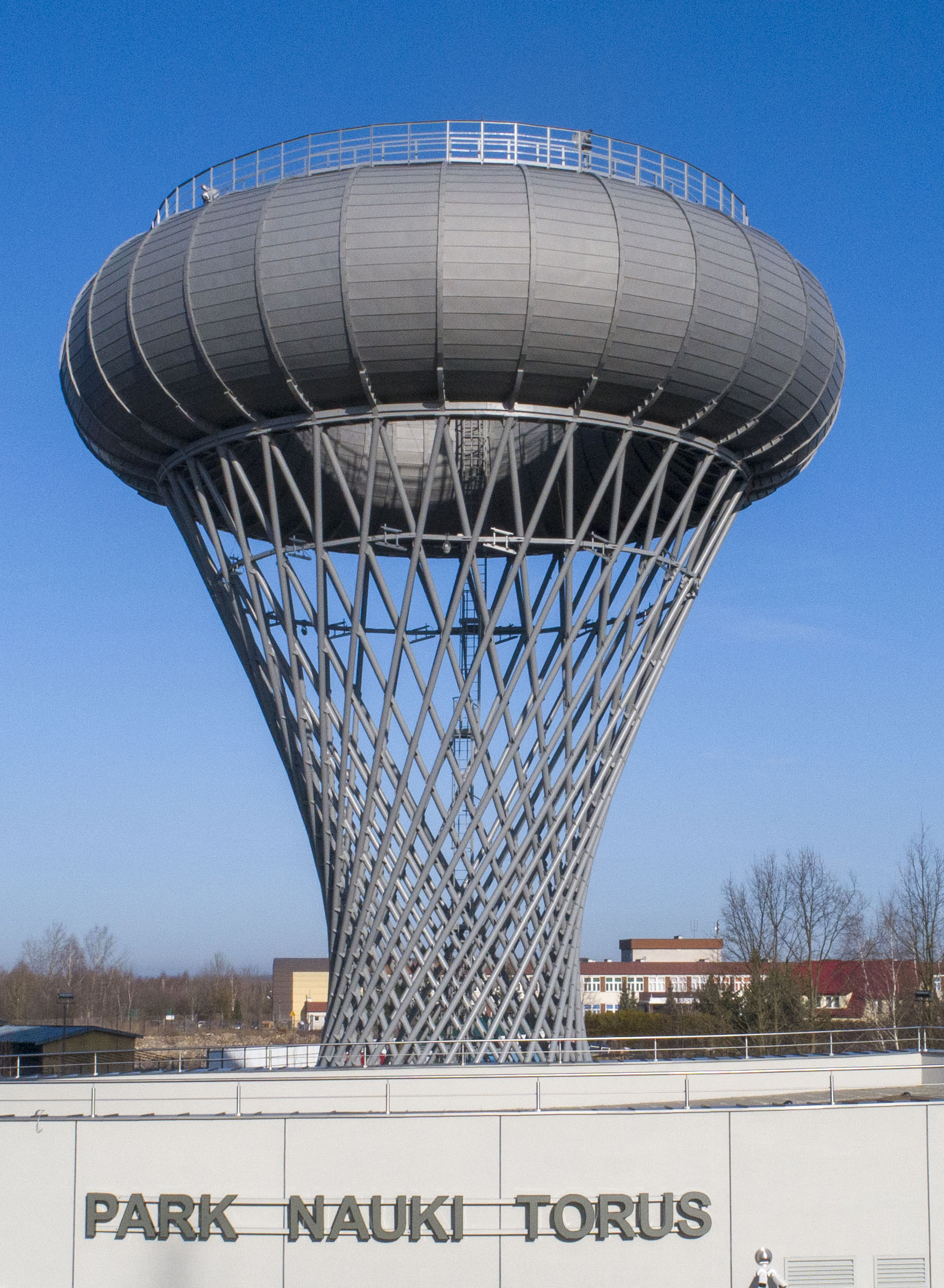Concept
Concept of the Torus Science Park creation
The aim of the Torus Science Park is encouraging people to learn throughout their entire lives by experiencing science directly while, at the same time, increasing local patriotism and devotion to the region.
Vision
While experiencing science directly, people are able to develop their critical thinking and feel a profound need to pose questions and search for answers. The Park gives also an opportunity to connect with the heritage of Ciechanow and appreciate its value.
Park’s role in education
The Torus Science Park – like every science centre – has a prominent role in educating the society. The Park is, most of all, a facility which popularises science, bringing it closer to the visitors of all ages, thus makes the lifelong learning idea possible. As an institution which makes tools and study aids accessible, it influences gaining knowledge directly. One of the Park’s goals is to support and enrich education offer existing within the state education system. The Park enables visitors to conduct experiments, discover laws of science and examine dependencies in the areas of physics, maths, technology and architecture. Due to engaging visitors into the Park functioning, our facility satisfies the need of conscious society willing to learn and take responsibility for this process. Motivating people to gain knowledge independently is definitely one of the crucial goals for science centres.
In the face of rapid changes occurring in the modern world, the society must be ready to adapt through, for instance, ability and willingness to learn, self-development or modifying one’s career path. Such flexibility requires openness to change, courage in entering previously unknown fields and readiness to acquire new skills.
The Park’s functioning will support the process of formal education offered by the state educational system. Both substantive content of the exhibition and form of using it contribute to the development of students’ competencies required by the formal educational system. Students can examine different phenomena single-handedly, search for cause and effect processes or come to independent conclusions. All these are included into the core curriculum of all school subjects and recommended by many experts in a given field. The Park’s substantive content of exhibition touches upon problems from maths, physics, technology and art, so it somehow constitutes a symbiosis of science, culture and art. The exhibition has got a chance to become a crucial factor in the teaching process conducted by primary and secondary school teachers. Many exhibits will allow to look at science issues from a totally new perspective.
Educational exhibition
All research points located in our exhibition have been designed in such manner so as to highlight their interdisciplinarity – co-relation between issues described by various branches of science. It constitutes a very important factor, which is often hard to obtain in the standardized school environment. The Torus Science Park gives one more great advantage – makes its visitors familiar with local heritage through exhibits connected to the history of the castle in Ciechanow and to the structure of the water tower. Both, the castle and the water tower, are important not only for local history, but are also recognised as extraordinary historic sites on Polish map. The Park will be attractive for science lovers and art lovers as well. The fact, that our town aims at supporting young students, especially in maths education cannot be stressed enough, as the main support should be given to groups under the threat of exclusion, struggling financially or with poor prospects.
Torus, due to its science exhibition, has a chance to encourage students to pursue knowledge on their own and shows that it can be a real fun, as the Park offers games and experiments perfect to engage children and teenagers into the learning process. The Torus Science Park is a response to modern research on the learning process, which points out the meaning of emotions in education and how having fun and experiencing science through all senses contributes to the enhancement of this process as information acquired in that way is remembered longer.
History
Learn about the water tower history!
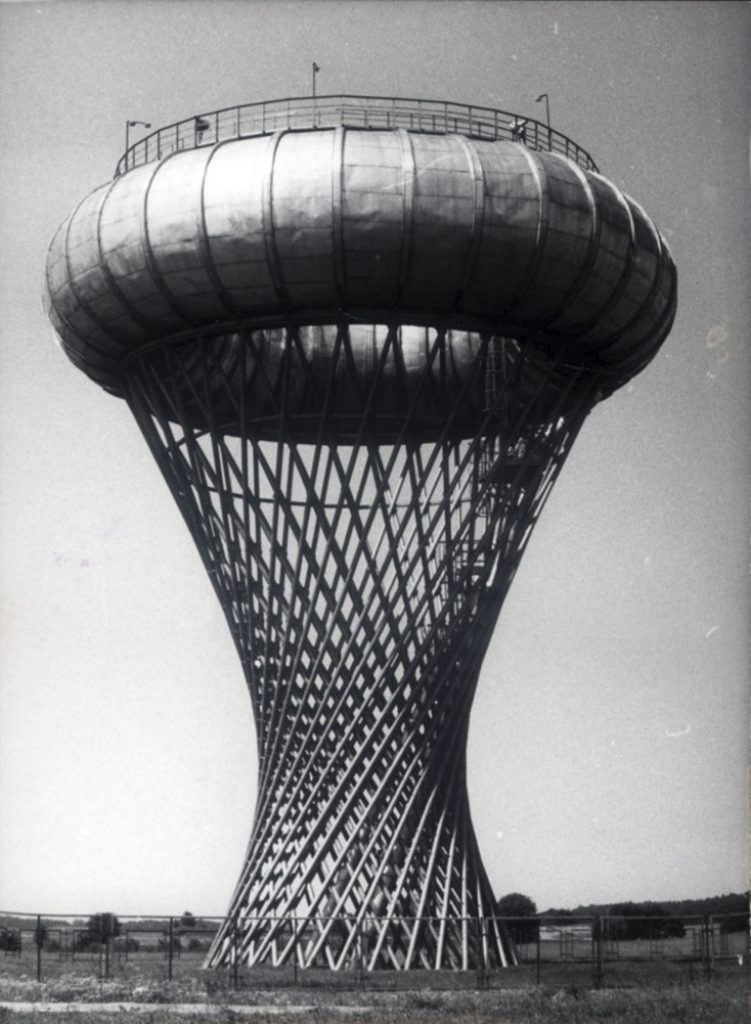
Is that tower a real water tower?
As a matter of fact, this distinctive structure called the water tower is not a real water tower. The name was coined many years ago and probably nobody in Ciechanow can even imagine to call it differently. Sometimes, while speaking about it, people use nicknames like ‘mushroom’ or ‘tyre’. Nonetheless, it remains ‘the water tower’.
To be precise, the building with torus on its top is an expansion tank for water. It has been an inseparable landmark of our town for almost fifty years. This extraordinary and extremely attractive structure is one of Ciechanow’s symbols. Interestingly, this place has never been used as its construstors planned and it was only partially maintained for a very short time in the past.
Expansion tank urgently needed
The creation of the expansion tank tower was connected to the rapid growth of the industrial district of Ciechanow in the 1970s. The district itself was designed in previous years by ‘Miastoprojekt Mazowsze’ agency with supervision of engineer Ryszard Czugajewski. The main architect stressed the necessity to build an expansion tank, because then existing demand for water supplies with fully operating industrial district was estimated to reach 3600 m3 per day.
Some factories and technological processes required constant water flow of specified pressure, which was not always possible due to the imperfect town water system. Two water supplies were being used at that time: older one at 17 Stycznia Street, located 4 km away from the planned construction, and the other one on Gostkowska Street, which was much more efficient, but located 6 km away. In order to balance water pressure, the architects decided to build the expansion tank in one of the highest points in Ciechanow just next to the industrial district. Ciechanow is located at approximately 118 m above the sea level and the building is at 143 m above the sea level. Due to financial issues, local authorities decided to use the water supply on 17 Stycznia Street to power up the expansion tank and to include it into Ciechanow’s water system.
The documentation was created in two versions – in the first one the tower was to be made of reinforced concrete, in the second one the structure would be made of steel. The first version was rejected as investors failed to find suitable contractors and the second version came into being. The expansion tank made of steel presented a peculiar math formula and was designed in 1972 in cooperation with many partners. It was meant to be a prototype, the first building of such form in Poland. Team of constructors from Designing and Researching Construction Office ‘Miastoprojekt Budopol’ cooperated with Institute of Water Management and Water Engineering from Warsaw University of Technology and Centre of Municipal Technology in Warsaw. The main team of our tower creators consisted of: Dr Józef Wilbik, engineer; Dr Stanisław Gajowniczek, engineer; engineer Stanisław Lorenc, MA; engineer Andrzej Oleszyński; engineer Stanisław Majkowski, MA; engineer Ryszard Czugajewski, MA; engineer Józef Fabianowicz, MA and technician Michał Zieliński. According to assumptions, the expansion tank was to serve as a reservoir gathering water supply during the night, while the demand was at the lowest. At peak hours, when water demand grew rapidly, the tower was supposed to increase water pressure by releasing its supplies and provide a sufficient water flow of the water system of the industrial district, so as to ensure continuity of technological processes.
Mathematical shapes
The novelty of the project consisted in creating a special shape of water tank, in order to contain large amounts of water, while, at the same time, sustaining small difference of water column height. What is more, the whole structure was put on a tower with distinctive design. Mathematical formulas call such structures a torus installed on a one-sheet hyperboloid revolution. The expansion tank was designed as a torus created by horizontal rotation of a circle with 6 metre diameter rotating within 8.75 m range. It was the first structure of this type in Poland. The final project was created with the help of multiple tests and simulation, during which many models on a scale of 1:50 and 1:20 were destroyed.
Already during the design phase, the citizens of Ciechanow felt excitement connected to this project and an expansion tank model on a scale of 1:20 had been carried for many years during the First May Day Marches by workers of the Department of Water Supply and Sanitation. It served as an example of Ciechanow entering modern times and gave hope of improving the water supply system.
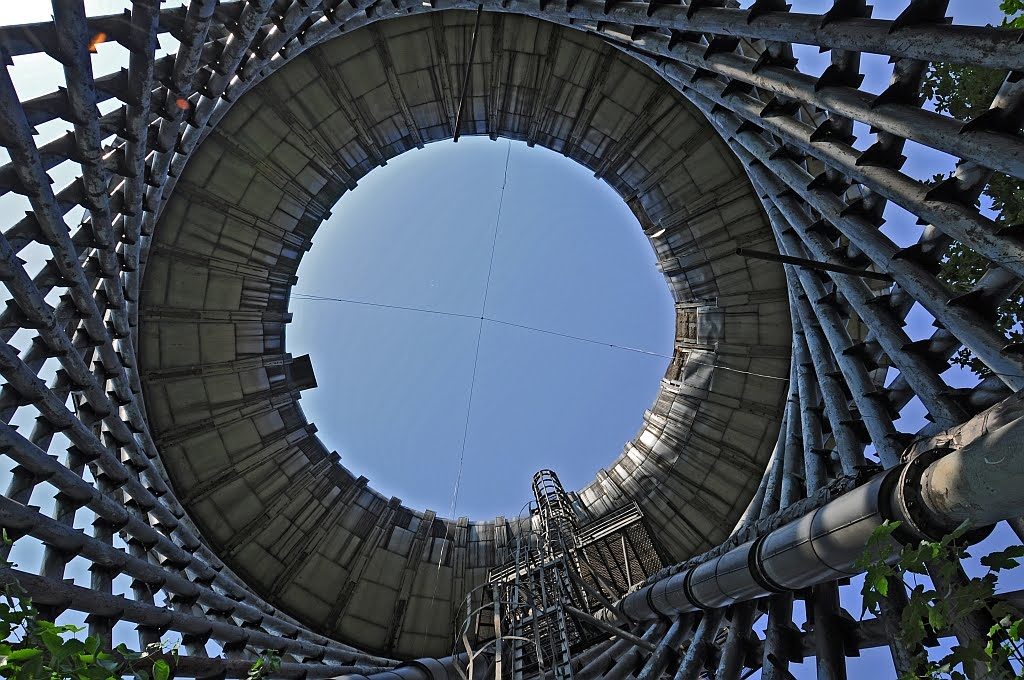
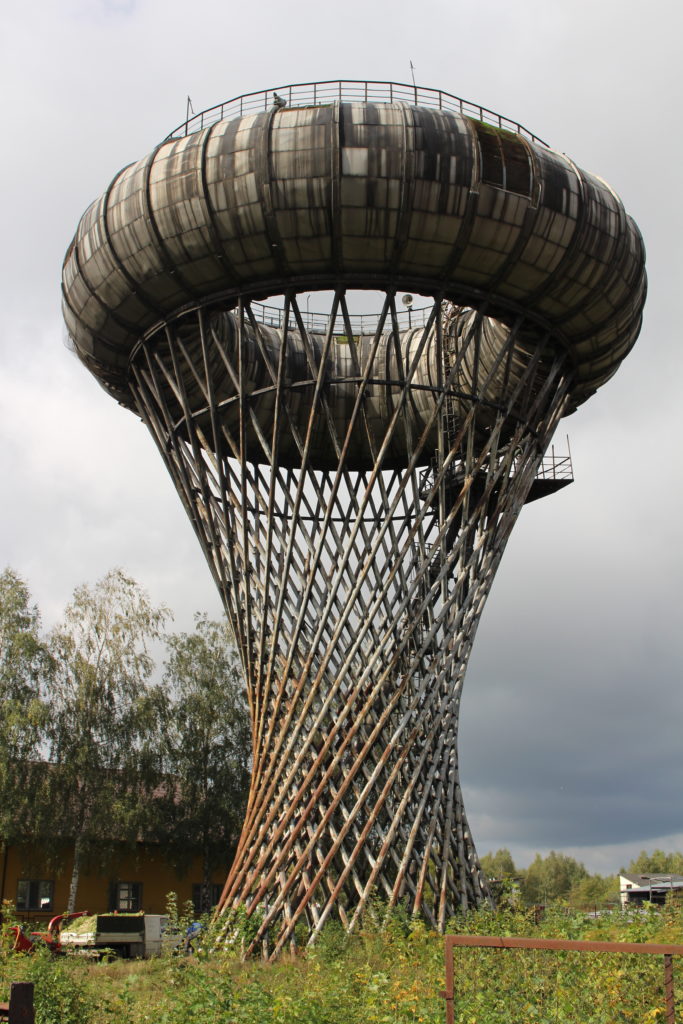
Construction process and mechanism
The contractor of our tower was ‘Mostostal’ Plock and the first builders entered 4200 m2 site in October, 1974. The unique openwork structure made of steel was put on the ring-shaped reinforced concrete foundation. Sixty-four tubes inclined at a 60o angle were used and their tops were displaced accordingly as to create a geometric figure recognized as a one-sheet hyperboloid. Their diameter was 6 m. Thermal insulation was made of glass wool mats of 60 mm thickness. These mats were covered with a mesh and, additionally, aluminium sheet was used as an outer protective layer. Contacts between sections were sealed with rubber gaskets. Whole structure weighed 165 tons. Grofeten, a hydraulic crane with a lifting capacity of 75 tons, was used during the construction process, then a test of full load was conducted. The expansion tank was filled with water for the first time on 8th June 1976, what was recorded in a protocol. Soon, on 29th July 1976, the tower was put into service.
The tower has two platforms. The upper one, called a communication bridge, spreads around the upper surface of the torus. The lower one, called a technical bridge, goes under the torus and is attached to the upper parts of a supporting construction. It was created to service valves of water pipes. The platforms were made of openwork steel material and a safety railing. They were accessible by a steel ladder with safety headbands. Whole site, where the expansion tank was built, was fenced.
Apart from its design, construction and technological uniqueness, and its extraordinary architectural value for Ciechanow, another important factor of our tower was its maintenance-free system of the tank – it was supposed to work without people attendance and almost no electricity was needed. Measuring devices installed inside the tank to control the amount of water and signal devices with probes, which indicated when the tank was full or empty – all that system was to save as much power as possible and to ensure economical operation. Water from the town’s water system was supposed to fill the tank during nights and control devices installed in basement under the tower were to regulate all operations. Probes installed in the tank controlled electric valves. They opened or closed deadbolts located in water intake and in pumping station thanks to automatised electric drive. Emptying the tank was handled in the same way. During the high water demand, the tank was supposed to increase the water pressure in the water system for the industrial district and level up water for the rest of the town. In case of control devices failure, the tank was to be operated manually by deadbolts installed on the lower platform.
In addition to the automatised control device system, the tank had its openwork construction and torus brightly lit. Headlamps were installed in the upper and lower parts of the building, unfortunately, the illumination system worked only for a few years. Nonetheless, at that time, local authorities and Ciechanow citizens took pride in this beautifully lit construction located on route to Bydgoszcz and Plock, in the highest part of the industrial district. It was an outstanding landmark admired especially during nights.
Effective yet non-efficient
The expansion tank in Ciechanow due to its prototypical solutions was awarded 3rd level prize of the Minister of Housing and Construction Materials Industry in July 1977. The ceremony took place in the Cabinet Office building.
The building was put into service in 1976, but its functioning caused problems from the very beginning. On the first day a number of errors appeared as a result of faulty design and construction process, not following the architects’ project in the first place.
The biggest issue was filling the tank with water. The pipe system, which was supposed to pump water from pumping station directly into the tank, was not finished due to financial cuts in the budget and was included as a final element into the town water system. What is more, there were huge pressure drops because of leakage in the water system. As a result water being pumped into the system from the water treatment plant reached the tank in a very small amount what prevented filling up the tank. In order to deal with this problem, a water intake located in the headquarters of PKS enterprise (Motor Transport Company) was connected to the system, but water pressure was still too low and all other attempts failed. Even a conveying pump installed at the base of the tower was unable to fill the tank. It was not the only problem, though. During the memorable winter of 1978 and 1979, when freezing temperatures reached Ciechanow, pipes supplying water into the tank busted, because expansion compensators were not installed. Watered continued to freeze in the following years as well. As a result, the tank has never served its designed purpose. After first few tests and attempts to fill it with water, it was shut down, just three years after it was opened.
New life for an architecture gem
The tank had been abandoned for years and prone to slow and imminent degradation. From time to time, unrealistic ideas and projects appeared; for example, to build a panoramic platform on the top of the torus or arranging its inner space into a restaurant. Our water tower became really popular in 2013, when the portal The World Geography put it in 5th place in a rating of the most unusual towers in the world. In February 2014 the structure was included into the voievodiship list of engineering monuments, but the situation did not change and the water tower remained abandoned.
Year 2017 brought new hope for the tower as it was taken over by the Department of Water Supply and Sanitation and received an EU grant for more than 2.7 million PLN. The town began revitalization and finished it by the end of 2018. The construction has been strenghten, cleaned and painted, the torus got new plating made of titanium-zinc sheet. The tower was lit and a fountain was built around it. The idea of revitalization did not focus solely on the tower, but aimed at turning it into a trademark of a science park. A modern two-storey building of the Park was built just next to it and the area around it was redesigned.
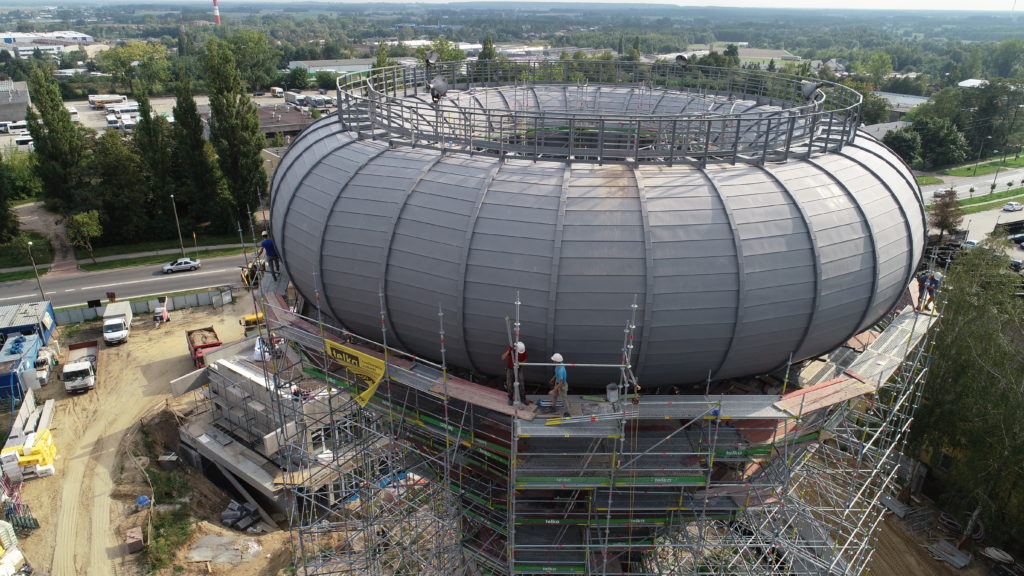
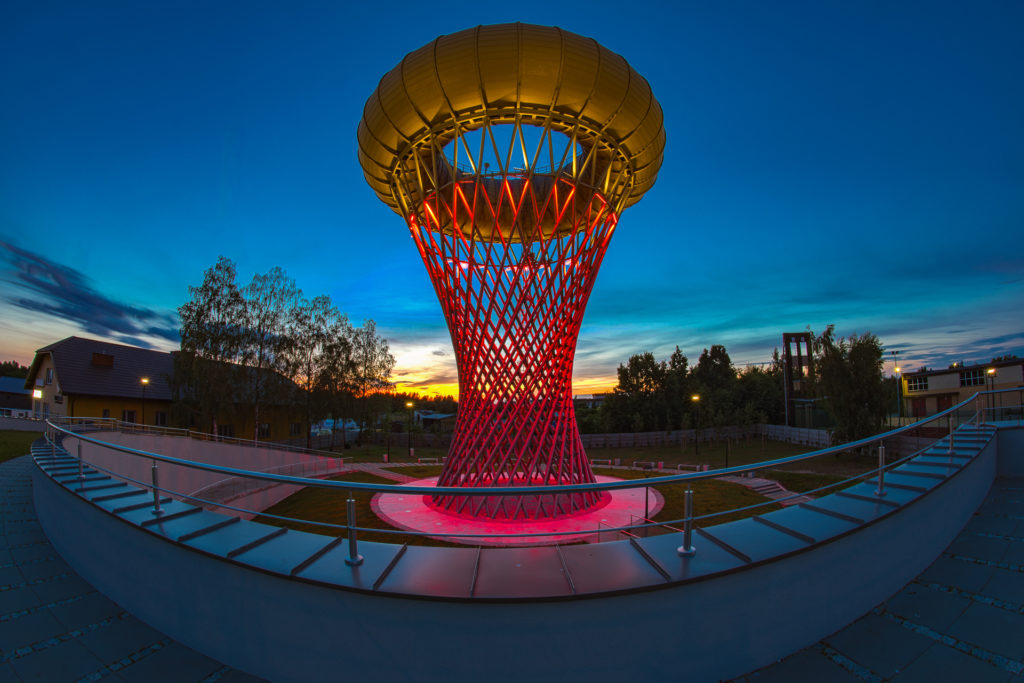
Check how the water tower has changed !
Slide the picture
